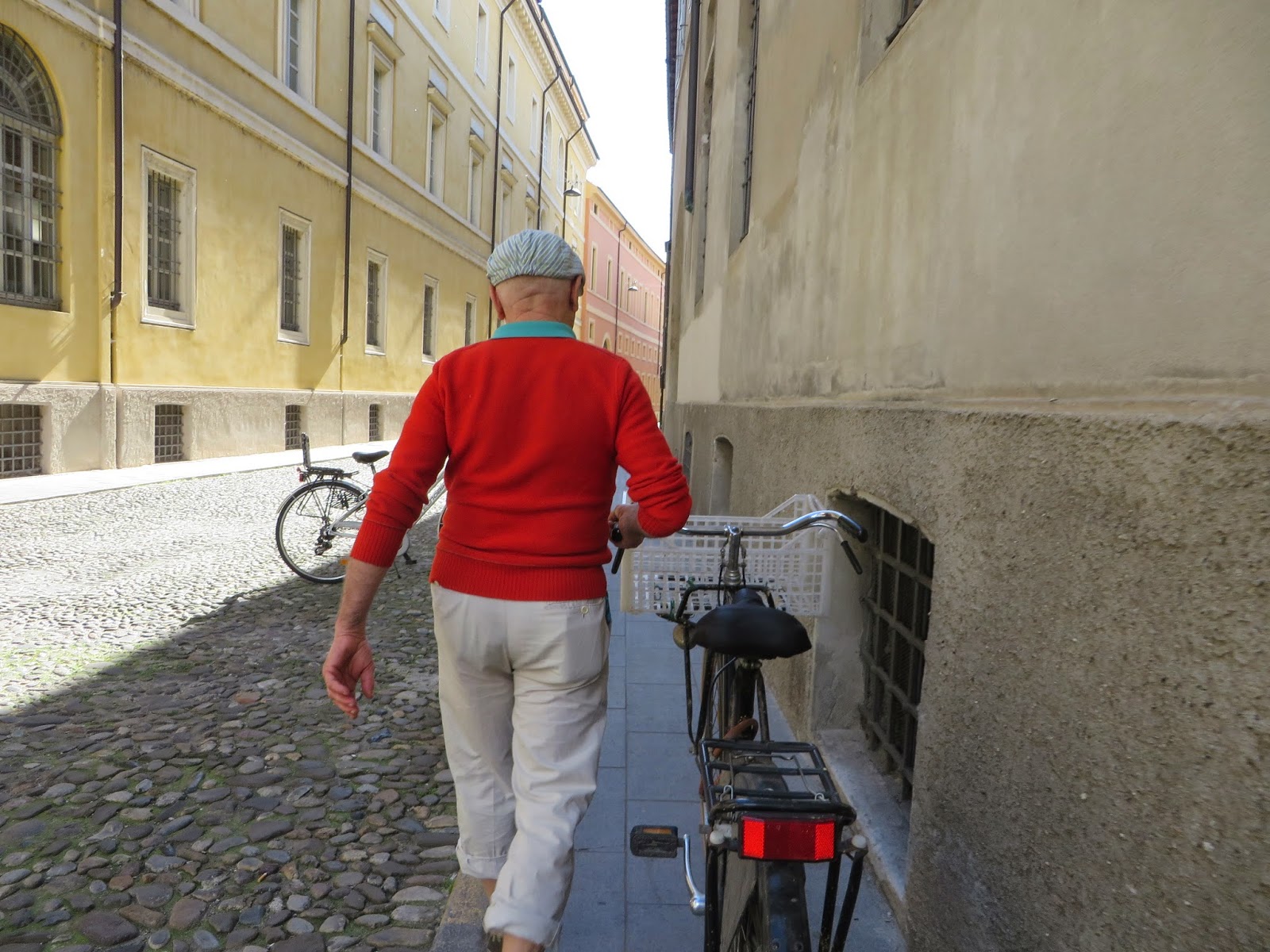One hardship Italy faces is the responsibility of
maintaining its long and distinguished history. Remnants of the ancient world
are everywhere at hand in Italy, and preserving it all requires tremendous
financial commitment. It is hard to widen a road or construct a new building
anywhere in Italy without digging up an Etruscan tomb or a Roman villa. One
evening in Riva del Garda Jan and I went to an outdoor dance, held on top of an
underground car park. We were surprised to notice that one corner of the
parking area was an active archaeological site. A Roman bath had been unearthed
there!
Because there is so much of it to see, entire lifetimes have
been devoted to absorbing the Italian heritage. Contemporary Italians remain
justifiably proud of their past. In lovely Cremona we met an older man on a
bicycle who insisted on taking us to his favorite churches. He spoke no English
and spent nearly two hours with us, but refused to accept any money. The man simply
wanted to share the beauty of his city.
Jan and I have been to Italy several times, but there is
always so much more to take in. On this trip we went to Milano, Ferrara, and Padova
(Padua), among other places, for the first time—and to Florence for the third or
fourth time. In future trips we look forward to revisiting all these cities, and to seeing places like Ravenna, Sorrento, Lake Como, and the Italian Riviera, which we still have yet to visit.
Our initial reason for going to Milan was to see Leonardo’s
“Last Supper.” We stayed longer than we had planned because Jan had HUG Your
Baby work to do and we found a very comfortable, serviceable, and affordable
accommodation there. But we also came to love the city and discovered it was easy
to get around on foot and by Travel Scoot.
The Milan Cathedral is truly a remarkable place, one of the
oldest and largest buildings in Christendom. Personally I prefer the quiet of a
small sanctuary, but this Duomo is literally breathtaking, not only in its size
and scope but also in the exquisite execution and completion of all its
beautiful details, from magnificent marble and stained glass windows to soaring
spires and stirring bells.
We placed our visit to “The Last Supper” (“L’Ultima Cena”) in
the hands of professional art educators. They walked us over to it, commenting
and answering questions from the group as we followed them along the old Roman road. But
before that, they offered an excellent PowerPoint lecture telling the story of
the painting, from Leonardo’s decision to try an experimental (and ultimately
flawed) technique to how the fresco was very nearly destroyed by Allied bombs
during World War II. Especially addressing us kinesthetic learners, they had
their students assume the poses of the figures in the painting—and they even
provided appropriate drapery. Are you surprised that Jan found herself in the
role of Jesus? I played doubting Thomas, disbelieving the statement Jesus had
just made: that one of his disciples would betray him.
As much as we admired this largest of Leonardo’s masterpieces, which he applied to the wall of a monastery’s dining hall from 1495-1498, we were even
more captivated by Giotto’s magnificent frescoes in Padova’s Scrovegni Chapel, which he completed during the first decade of the 1300s. These magnificent frescoes have
been lovingly preserved for 700 years.
They cover all the walls as well as the barrel-vaulted
ceiling of the chapel, and they tell the story of the Virgin Mary and her role in
human salvation. We were touched by the humanity of Giotto’s figures, amazed by
the way he even painted faux marble pillars and frames to separate the panels
of his story, and stunned to learn that he himself was probably the building’s
architect.
We also loved the beautifully maintained medieval streets in
this old university town (Galileo lectured here!) and followed them down to the
marvelous “Il Santo” basilica.
Humbled by our exposure to so much beauty in Milan and
Padova, Jan and I decided to revisit Florence. She especially wanted to see
Michaelangelo’s “David” again. We discovered that it was a real deal to be
disabled in Florence. Not only did we both get into all the museums free, there
was never any waiting. We shot right up to the front of the line, where the
crowd-control tapes were lifted for us to enter! Another choice we are glad we
made in Florence (though its thick walls hampered our Internet access) was to
stay in a converted Renaissance church. For ten days we lived in a building
older than “America” itself.
Looking for affordable things to do for fun in Florence, I
noticed that an American art historian would be speaking—and reading from his
new book about the David—at an international bookstore one afternoon. We liked
Victor Coonin’s talk, and Jan bought his book, which turned out to be an
exceptionally well-informed and well-written account of its subject. Knowing
more about the process of the sculpture’s creation, and the long story of its
life, made our return visit to David even more meaningful. While Jan lingered under David’s
dome, I made time to visit the Academia’s marvelous collection of musical
instruments. Wow!
Italy is a thoroughly pleasant, friendly, and inspiring place to visit. Though
Italian history contains more than its share of misery, the majesty of human achievement, and the longing of the spirit
to surpass itself, outshine the darkness of the past to inspire the best
in us today. That's why we came to Italy, and why we hope to return!












No comments:
Post a Comment